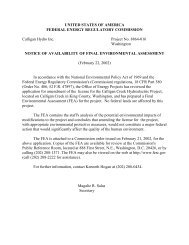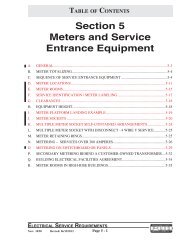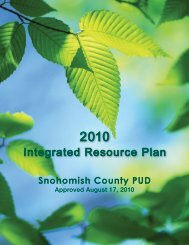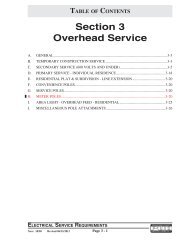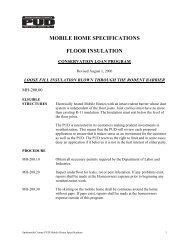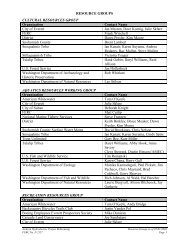Tidal_PAD_V1_Sec4.pdf - Snohomish County PUD
Tidal_PAD_V1_Sec4.pdf - Snohomish County PUD
Tidal_PAD_V1_Sec4.pdf - Snohomish County PUD
Create successful ePaper yourself
Turn your PDF publications into a flip-book with our unique Google optimized e-Paper software.
<strong>Snohomish</strong> <strong>County</strong> <strong>PUD</strong> –Pre-Application Document<br />
4 – Existing Environment<br />
within the confines of the site. Most of the maritime traffic is recreational, although commercial<br />
traffic and the Victoria Clipper may use the pass as an alternate route if Puget Sound is too choppy.<br />
Agate Passage<br />
The lands on either side of this channel are primarily forested and residential in nature. Beaches<br />
tend towards sand and cobble. The Port Madison Indian Reservation, which includes a casino,<br />
occupies the western shore of the Passage, and State Highway 305 crosses the channel on a steel<br />
bridge whose trusses fall within the confines of the project area. Maritime traffic is primarily<br />
limited to recreational vessels.<br />
Rich Passage Project<br />
Land use along this channel is dominated by a combination of forest, beach and residential<br />
development. Beaches tend to be a mixture of sand and cobbles. Fort Ward State Park is located<br />
along the northern shore of the Passage, while Manchester State Park lies along the southern. To<br />
the south of Manchester State Park is the Middle Point and Orchard Point Military Reservation.<br />
Naval vessels, including aircraft carriers, pass through the channel to reach the Puget Sound Naval<br />
Shipyard at Bremerton. A ferry travels from Seattle through the channel to Bremerton and back<br />
again. In addition, commercial vessels use the passage to transport goods and materials (Polagye<br />
et al. 2007).<br />
4.9 Aesthetic Resources<br />
Residents and visitors are drawn to the Sound to enjoy its scenic vistas, relax on its shores, and to<br />
observe its abundant wildlife. The basin was shaped by the carving and till deposition of glaciers<br />
that retreated as recently as 13,000 years ago (Booth and Goldstein 1994). Nestled between the<br />
Olympic Mountains to the west and the Cascade Mountains to the east, the basin is surrounded by<br />
valley walls that descend through rolling hills before reaching the lowlands that form the periphery<br />
of the Sound itself. The estuary has over 4,000 km of shoreline that encompass 7,250 square<br />
kilometers of inland marine waters (Gelfenbaum et al 2006). These waters are fed both by the<br />
Pacific Ocean and by the rivers and major streams that drain the adjacent watershed.<br />
4-188 January 31, 2008




